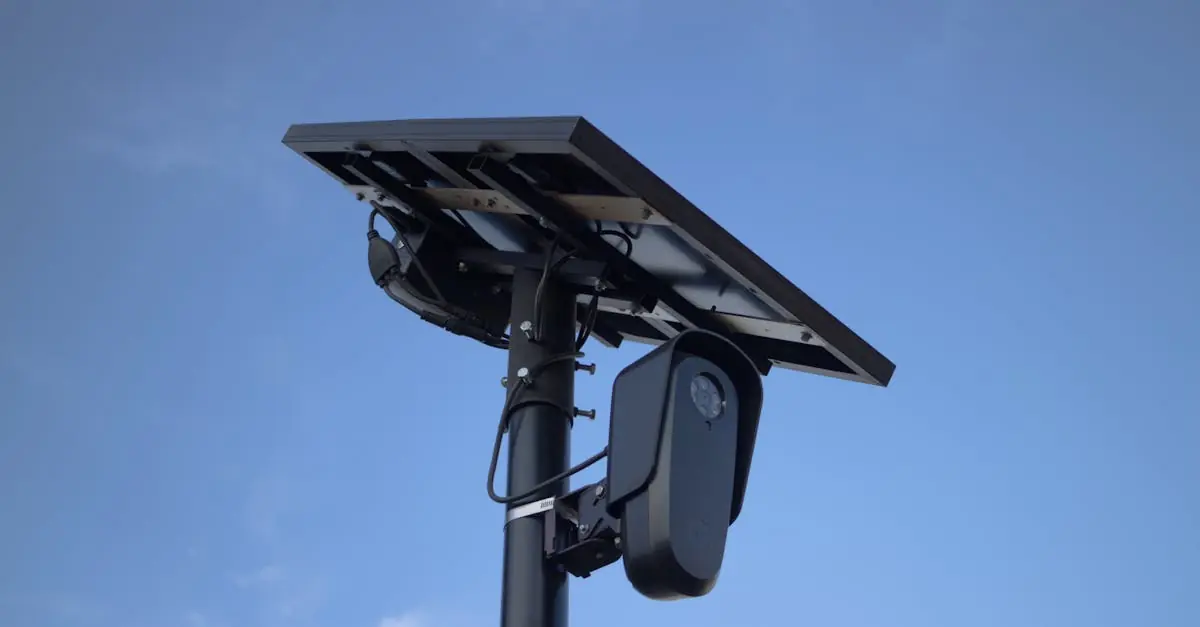Table of Contents
ToggleIn a world where even the squirrels seem to have a plan, securing your home has never been more important. Home security cameras aren’t just for the paranoid; they’re for anyone who values peace of mind. Imagine catching that sneaky raccoon raiding your trash or keeping an eye on the kids while you sip coffee on the porch. With the right installation, these little tech wonders can turn your home into a fortress—minus the moat and drawbridge.
Importance of Home Security Cameras
Home security cameras play a crucial role in safeguarding properties. They act as a deterrent to potential intruders, discouraging break-ins simply by being visible. Crime statistics show that properties equipped with surveillance cameras face lower burglary rates, creating a safer community environment.
Monitoring activities around the home becomes easier with security cameras. Homeowners can keep an eye on their property in real-time, providing reassurance when away. Many systems offer alerts, notifying users of unusual activity, which enhances overall security preparedness.
Specific features of modern cameras provide further benefits. High-definition video captures details vital for identifying intruders. Night vision capabilities allow for continuous monitoring, ensuring security around the clock.
Cameras serve diverse purposes beyond crime prevention. Surveillance helps monitor children playing outside or ensures the safety of pets in the yard. Such versatility highlights their importance in daily home management.
Integration with smart home systems enhances security effectiveness. Cameras can be synchronized with alarms and smart locks, creating a comprehensive security solution. This interconnectivity allows homeowners to control their security settings through mobile apps, increasing convenience.
Ultimately, the presence of security cameras fosters peace of mind. Homeowners gain confidence knowing they can monitor their environment at any time. This reassurance empowers individuals to focus on their daily lives without constant worry about potential threats.
Types of Home Security Cameras
Home security cameras come in various types, each tailored to specific monitoring needs. Their unique features make them suitable for both indoor and outdoor use.
Indoor Cameras
Indoor cameras primarily monitor interior spaces of the home. They often feature two-way audio, allowing homeowners to communicate with family members or pets. Many models include motion detection and night vision capabilities, enhancing visibility during low light conditions. Homeowners can secure areas like living rooms, hallways, and nurseries by strategically placing these cameras. Some options even offer cloud storage for recorded footage, making it easy to access video at any time.
Outdoor Cameras
Outdoor cameras focus on securing the exterior of properties. These devices are built to withstand harsh weather conditions, ensuring durability. High-resolution video and wide-angle lenses capture clear images of the surroundings. Additional features, such as motion-activated alerts and infrared night vision, enhance security. Homeowners can deter intruders and monitor entrances, garages, and yards effectively with outdoor cameras. Many options integrate seamlessly with existing security systems for comprehensive protection.
Wired vs. Wireless
Wired and wireless cameras each offer distinct advantages. Wired cameras typically provide stable connections and aren’t prone to signal interference. Installing these systems may require professional assistance due to cabling needs. Conversely, wireless cameras offer flexibility during installation and placement, as they connect via Wi-Fi. They are easier to set up, making them popular among homeowners with limited technical skills. Selecting between wired and wireless depends on individual preferences and the desired complexity of the security system.
Installation Process of Home Security Cameras
Effective installation of home security cameras is essential for maximizing their benefits. Placing the cameras correctly enhances surveillance and accessibility.
Choosing the Right Location
Select locations that cover all entry points. Front doors, back doors, and windows are crucial areas. Additionally, high-traffic zones like driveways and porches enhance monitoring. Avoid blind spots to ensure comprehensive coverage. Consider mounting cameras at elevated positions for better visibility. Indirect lighting can also prevent glare on the lens.
Tools and Equipment Needed
Basic tools simplify home security camera installation. A drill and screwdriver enable easy mounting. Additional tools like a ladder facilitate access to higher areas. Tape measures ensure accurate positioning. A level tool guarantees that cameras are perfectly aligned. Cables or an appropriate power source may be necessary for wired cameras. Wireless options might require a smartphone app for setup and control.
Step-by-Step Installation Guide
Begin the installation by marking locations for the cameras. Use the drill to install mounting brackets securely. Attach the camera to the bracket once the mounts are in place. Connect the necessary cables if using a wired system. Install batteries for wireless models, if applicable. After setup, test each camera’s feed for optimal positioning. Review footage during different times of day to ensure clarity and coverage. Adjust as needed to enhance surveillance effectiveness.
Best Practices for Home Security Cameras Installation
Effective installation of home security cameras enhances their usefulness. Proper positioning ensures cameras capture critical areas around a property.
Ensuring Optimal Coverage
Select camera locations that capture all entry points. Cameras should monitor doors and windows to prevent potential intrusions effectively. Installation in high-traffic areas maximizes visibility and monitoring capabilities. Consider using multiple cameras for extensive coverage across large properties. Elevate cameras to reduce blind spots, capturing activity from a broader angle. Aim for a clear line of sight, avoiding obstructions like trees or walls. Consult camera specifications to understand their field of view and adjust placement accordingly. Regularly review camera feeds to assess coverage effectiveness and make adjustments if necessary.
Protecting Against Tampering
Secure cameras against tampering to ensure their functionality. Use weatherproof enclosures for outdoor cameras, enhancing durability against environmental elements. Install cameras at elevated positions, making them harder to reach and obstruct. Opt for models with anti-tamper features, which can send alerts if tampering occurs. Regularly check camera positioning and connections to prevent disruptions. Integrate signage indicating surveillance presence, which can deter potential tampering or vandalism. Consider utilizing motion-sensitive alarms that activate if cameras are moved or obstructed. Regular maintenance and inspections help maintain camera integrity and security effectiveness.
Investing in home security cameras is a proactive step toward enhancing safety and peace of mind. With the right installation and placement, these cameras serve as effective deterrents against intruders while providing real-time monitoring of properties. Homeowners can enjoy the flexibility of choosing between wired and wireless systems based on their specific needs.
By following best practices for installation and maintenance, individuals can maximize the effectiveness of their security cameras. Regular checks and updates ensure that the system remains reliable and efficient. Ultimately, incorporating home security cameras into a security strategy not only protects the home but also empowers families to live without constant worry.



